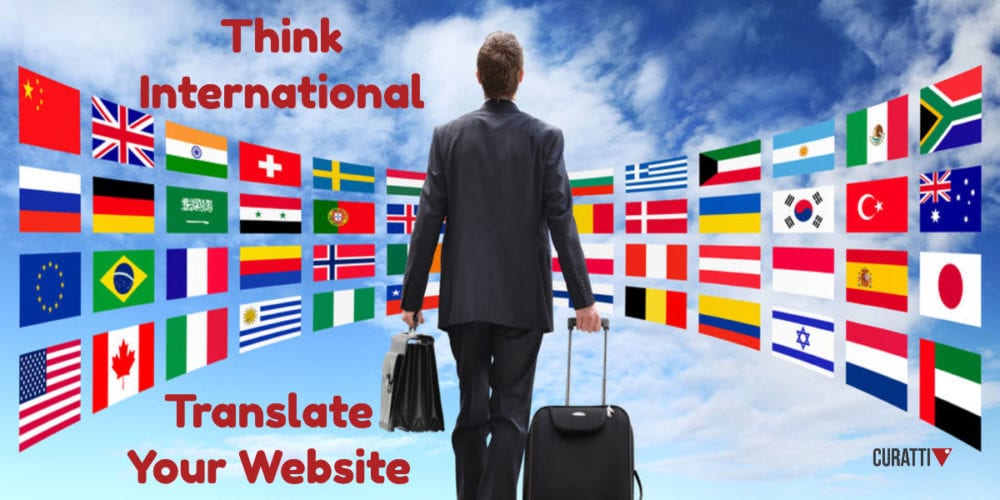The Business Benefits Of Website Translation and Localization

OK, you have published valuable content on your website. How do you maximize its reach? One of the easiest ways is to go after new languages and foreign markets.
How do you most efficiently get your web content to speak the language of foreign audiences and make sure you don’t alienate them? Here are some key terms and tips for getting started in smart translation and localization.
Let’s start with the obvious. There’s a whole industry of professional website translation services that exist for exactly the purpose of globalizing valuable content.
My own agency is in this field, and my experience as its CEO, growing Tomedes into a leading player in its industry, has given me some insight into how content creators can actually do without an expert agency like my own.
But this article is not to promote a translation agency – mine or anyone else’s. It is to help you, as a content creator, to make smart choices about getting your content out of your mother tongue language and into additional languages.
We will discuss how to maximize your reach and influence so that you can expose your content to new international audiences more cost-effectively. There’s always the option to turn to experts and pay a premium for that additional security and professionalism. But the truth is: you don’t need to!
So let’s leave turning to a professional language services agency off the table. Instead, let’s focus instead on how you can do it yourself. It’s easier than to translate your content due to the ease of accessing expert freelance resources and the vast improvement in translation tools.
The Difference between Translation and Localization
It’s important to understand the difference between two words that are thrown around a lot these days. The first is localization, which, depending on your location and context, may also be spelled with an ‘s’ (localization). Often, writers, editors, and content curators in English must first decide if they are using the United States or UK/EU/Australian/Canadian spelling and grammar conventions.
It’s a perfect example of how location and usage can change everything. You may not care whether you use “while” vs. “whilst” but your audience will, and it will be a dead giveaway as to whether you are perceived as being in tune with one or another of these conventions.
Localization, however, is much more than linguistic translation. It relates to the metric units you use, the currency you choose when referring to monetary amounts, or whether you punctuate large numbers or decimals with a comma or a full-stop.
All of these are elements of localization. But the subject extends to more subtle cultural issues of language usage. Some words that are perfectly acceptable for one audience but may be deeply offensive to another. For example, the slang word for a cigarette in Britain is a pejorative gender designation in the United States. So you need to know or learn these kinds of things at a deep level – or hire somebody who does.
Localization takes on a broader meaning when it comes to software generally, or apps in particular. There is a whole branch of the software industry dedicated to solutions for localizing applications in highly systematic ways.
But we are focusing on websites and social media here. So let’s just take the familiar case that many if not most sites and social campaigns need to be in more than one language. It’s important to note here that, while most western languages go from left to right (LTR). However, there are several important exceptions: Hebrew and Arabic, Chinese and Japanese.
Even among LTR languages, there are big differences between the average character counts of words. For example, the average word length in English is 8.23 characters while in German it’s 11.66. Web designers need to take these variations into account when choosing font sizes and menu contents. By so doing, the same design can be used in all local versions.
The Difference between Localization and Globalization
Localization is the process of adapting your content, media, or software to a particular local market. Globalization involves seamless integrating these local versions so that your content can be consumed and enjoyed in multiple languages and cultures.
Globalizing your content or apps requires designing and developing them for consumption or interaction by multiple markets or cultures. This means making your product multilingual and multicultural, like the world itself. It means making a product that makes local users comfortable and feeling “at home.”
Translation, of course, is the key aspect here. But all the other adaptations of metrics, currency and cultural idioms are part of it too. Another term that has crept in from the world of engineering is retrofitting. In this instance, it refers to localizing something not initially designed to be global.
It is often the first step taken by companies that did not have a globalization strategy in place at first, but were pushed to adapt what they had.
Working with Freelance Translators and Networks
Once you have a global strategy in place, you need to localize in a logical sequence. Which content and which languages do you tackle first? Which resources can get you started without breaking your budget?
The cost-effective option is to look for freelance translators in one of the online marketplaces that have arisen in recent years. There are quite a few that can work well. Some are focused on translation only, while others with a more general focus.
Let’s say you want to translate web content from English to Spanish. You would just register as a client at a site like Freelancer.com or Upwork.com and then post a job request calling qualified freelancers to compete for your project. You’ll be able to read the profiles, CVs, reviews and ratings, and view the portfolios of candidates. You can ask them questions, or set and evaluate test assignments.
One advanced tip is to look not just for one but two language translation resources, one of whom will edit and audit the other. That way you have a second opinion and two sets of “fresh eyes” for your product.
You will also want to have some trusted or sympathetic locals to be test readers who can give you feedback on the freelancers you hire.
Working with Machine Translation Tools
If you want to translate a website to or from English, you may be pleasantly surprised at how far you can get with the latest generation of neural net translators. A good idea, if you’re going from English to a foreign language, is to first improve the quality of the source using tools like Grammarly, Whitesmoke, or Ginger. These tools can help you find what’s wrong or clumsy in your English – before you translate it.
In terms of AI-driven neural machine translation (NMT) tools, you may be surprised how accurate and “natural” Google Translate has become in recent years. There are also interesting up-and-comers like Deep L or Smartcat. Watch out for “free” translation agencies. Often the “free” refers to a free quotation, which is par for the course for translation agencies. But there’s no need to go through an agency to get NMT.
Many of these tools are free, but you would be foolish to rely on them alone. What they can do, cost-effectively, is give you a head start in your localization/globalization project.
Always hire a local or a translation agency to double- or triple-check your automated translations. However, the results of this hybrid process can be surprisingly good, and cost-effective.
Translation and Curation of Content
Ultimately, you need to treat your content with the same respect in foreign languages as you accord it in your mother tongue. In other words, you need to apply the principles of curation to the translation, localization, and ultimately globalization of your content.
One word to the wise is not to bite off more than you can chew at first. Decide which local languages will give you entry to the most attractive and lucrative foreign markets. Then focus on following the above best practices to do those 2 or 3 languages well. With several under your belt, the next several will go quickly, and less expensively.
Ultimately, the secret for successful translation, localization and globalization can be found in the essence of content curation.
Think of a foreign language as an art exhibition or collection. Your job, using expert human resources and automated tools, is to select and arrange words as a collection, then “look after” them in a way that retails and augments their inherent value.
Think of globalization as an exercise in artistic curation. You are assembling a collection of local versions of your content, presenting them as a unified whole. The appearance and content quality should validate your global investment and win kudos from visitors worldwide.
Related reading: 5 Tips For ESL Writers To Become Successful In Content Writing
 Ofer Tirosh is the founder and CEO of Tomedes, a professional translation company. Tomedes also offers website translation and localization services, and has catered to more than 50,000 business clients in over 100 languages since 2007.
Ofer Tirosh is the founder and CEO of Tomedes, a professional translation company. Tomedes also offers website translation and localization services, and has catered to more than 50,000 business clients in over 100 languages since 2007.
You can find Ofer and Tomedes on Facebook, LinkedIn or YouTube, or you can follow/tweet them @Tomedes
Featured image: Copyright: ‘https://www.123rf.com/profile_visivasnc‘ / 123RF Stock Photo

CURATTI GUEST


